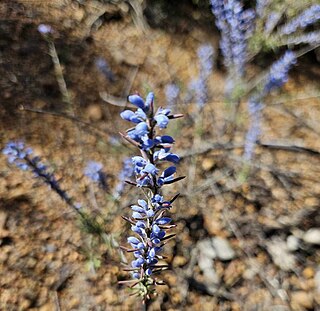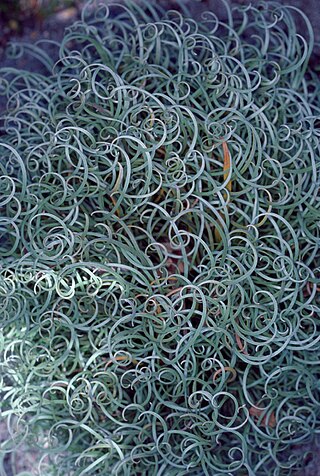
Conospermum acerosum, commonly known as needle-leaved smokebush, is a species of flowering plant in family Proteaceae and is endemic to the south west of Western Australia. It is spindly, erect or straggly shrub with needle-shaped or thread-like leaves, panicles of white or pink flowers and reddish brown nuts.

Conospermum incurvum, commonly known as plume smokebush, is a species of flowering plant in the family Proteaceae and is endemic to the south-west of Western Australia. It is an erect, spindly or prostrate shrub with densely arranged cylindrical leaves, and panicles of white, tube-shaped flowers with dark blue bracteoles.

Conospermum ellipticum is a species of flowering plant in family Proteaceae and is endemic to New South Wales. It is an erect shrub with hairy, elliptic leaves, panicles of cream-coloured to white flowers and golden, hairy nuts.

Conospermum amoenum, commonly known as blue smokebush, is a species of flowering plant in the family Proteaceae and is endemic to the south-west of Western Australia. It is an erect or spreading shrub with linear leaves, and spikes of blue or white tube-shaped flowers.

Conospermum boreale is a species of flowering plant in the family Proteaceae and is endemic to the south-west of Western Australia. It is an erect, much-branched shrub with egg-shaped to elliptic or lance-shaped leaves, and panicles of woolly, white flowers.

Conospermum bracteosum is a species of flowering plant in the family Proteaceae and is endemic to the south-west of Western Australia. It is an erect, spindly shrub with egg-shaped leaves, sometimes with the narrower end towards the base, and spikes of silky, woolly, tube-shaped white flowers.

Conospermum canaliculatum is a species of flowering plant in the family Proteaceae, and is endemic to the south-west of Western Australia. It is a dense, multistemmed, erect shrub with linear leaves and spike-like panicles of woolly white, tube-shaped flowers.

Conospermum capitatum is a species of flowering plant in the family Proteaceae, and is endemic to the south-west of Western Australia. It is a low, erect shrub with coiled leaves and head-like panicles of red to pale yellow and hairy, tube-shaped flowers.

Conospermum cinereum is a species of flowering plant in the family Proteaceae and is endemic to the south west of Western Australia. It is a spindly shrub with egg-shaped to lance-shaped leaves, loose spikes of woolly, tube-shaped white flowers and woolly nuts.

Conospermum coerulescens is a species of flowering plant in the family Proteaceae and is endemic to the south of Western Australia. It is an erect shrub with thread-like to narrowly lance-shaped leaves and spikes of up to 10 greyish-blue to deep blue, hairy flowers.

Conospermum croniniae is a species of flowering plant in the family Proteaceae and is endemic to the south-west of Western Australia. It is an erect, open shrub with spreading cylindrical leaves and spikes of up to 6 pale blue or pink, tube-shaped, hairy flowers.

Conospermum densiflorum, commonly known as crown smokebush, is a species of flowering plant in the family Proteaceae and is endemic to the south-west of Western Australia. It is an erect, much-branched shrub with thread-like leaves at the base of the plant, and spikes or corymbs of velvety, cream-coloured or blue, tube-shaped flowers.

Conospermum eatoniae, commonly known as blue lace, is a species of flowering plant in the family Proteaceae and is endemic to the south-west of Western Australia. It is a spreading shrub with egg-shaped leaves only present on young plants, and panicles of glabrous blue, tube-shaped flowers with pale green bracteoles.

Conospermum filifolium is a species of flowering plant in the family Proteaceae and is endemic to the south-west of Western Australia. It is a shrub with thread-like, S-shaped leaves, and spike-like panicles of woolly white, occasionally blue, tube-shaped flowers.

Conospermum flexuosum, commonly known as the tangled smokebush, is a species of flowering plant in the family Proteaceae and is endemic to the south-west of Western Australia. It is a sprawling shrub with many zig-zag branches, panicles of white to pale blue, tube-shaped flowers and urn-shaped, hairy nuts.

Conospermum floribundum is a species of flowering plant in the family Proteaceae and is endemic to the south of Western Australia. It is a compact, erect shrub with narrowly linear leaves that are circular in cross-section, and spike-like panicles of white, tube-shaped flowers with blue tips.
Conospermum galeatum is a species of flowering plant in the family Proteaceae and is endemic to the south-west of Western Australia. It is an open shrub with threadlike, channelled leaves, and panicles of spikes of woolly white flowers with blue bracteoles.

Conospermum huegelii, commonly known as the slender smokebush, is a species of flowering plant endemic to the south-west of Western Australia. It is a low, clumped shrub with thread-like to narrowly cylindrical leaves, and spikes of pale blue to cream-coloured, tube-shaped flowers and hairy nuts.

Conospermum hookeri, commonly known as Tasmanian smokebush, is a species of flowering plant in the family Proteaceae and is endemic to Tasmania. It is a shrub with many branches, spatula-shaped or linear leaves, panicles of spikes of white, tube-shaped flowers and reddish brown nuts covered with silky fawn-coloured hairs.

Conospermum burgessiorum is a species of flowering plant in family Proteaceae and is endemic to eastern Australia. It is an erect to spreading shrub with linear leaves, panicles of cream-coloured to white flowers and reddish brown nuts.




















